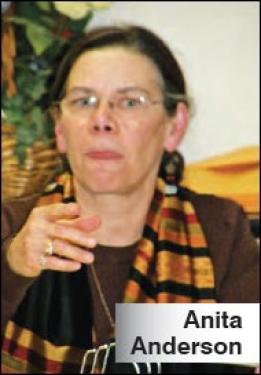
Image 1 of 5
Mountain students have everything they need to succeed, it appears, if there are involved parents, creative community mentors, supportive administrators, excited teachers and a stable program. Above, some of the 16 local students who competed at the Kern County Science Fair:(l-r) Fletcher Matthews, David Nelson, Rachel Hallmark, Michael Stegeman, Kelly Stegeman and Lily Hallmark.![At the March 14 board meeting, trustees and the public heard an upbeat report from ETUSD Fiscal Director Terri Geivet and Superintendent Katie Kleier about the loss of $133,00 to $144,000 in ADA because of failure to document attendance at the high school last year for independent study students. The upbeat part? We could have lost much, much more because basic administrative records were not kept. Attendance records for the whole school were recompiled [See report last week] [Hedlund photo for The Mountain Enterprise]](https://mountainenterprise.com/fds/images/story/fs_10061_2.jpg)
Image 2 of 5
At the March 14 board meeting, trustees and the public heard an upbeat report from ETUSD Fiscal Director Terri Geivet and Superintendent Katie Kleier about the loss of $133,00 to $144,000 in ADA because of failure to document attendance at the high school last year for independent study students. The upbeat part? We could have lost much, much more because basic administrative records were not kept. Attendance records for the whole school were recompiled [See report last week] [Hedlund photo for The Mountain Enterprise]
Image 3 of 5
Current ETUSD Board President Paula Regan used the gavel often to tell parents and community members they were not welcome to ask questions during the meeting March 14. Her current term is up this November. She has been on the board since 2003—nine years. Trustee John Fleming's term also expires this year.![Trustee Stephan Kiouses said he wants to talk about "operational ideas to stop living on the edge." He is interested in talking about closing buildings. If he wants to serve as a trustee next year, he will have to stand for election in November. Ken Hurst has served for two terms and his seat is up for election this year as well. [Hedlund photo for The Mountain Enterprise]](https://mountainenterprise.com/fds/images/story/fs_10061_4.jpg)
Image 4 of 5
Trustee Stephan Kiouses said he wants to talk about "operational ideas to stop living on the edge." He is interested in talking about closing buildings. If he wants to serve as a trustee next year, he will have to stand for election in November. Ken Hurst has served for two terms and his seat is up for election this year as well. [Hedlund photo for The Mountain Enterprise]
Image 5 of 5
Anita Anderson is in her second term. She ran on the platform of transparency and greater parent participation. She has another two years to serve in her current term.
Report and Commentary by Patric Hedlund
We are running out of time. Whether you have children in the El Tejon Unified School District or not—and whether you’ve given it thought or not—your life, the vitality of your community, the prosperity of your local businesses, the value of your home and your own bank account are being affected right now by the success or failure of your local school district.
Every real estate professional will tell you the same thing: “location, location, location” is often shorthand for “how good are the schools in your location?”
Confidence in our local schools can translate into a more robust recovery of the real estate market.
This Mountain Community has been and should be a beautiful place to grow strong and capable children. Strong schools attract solid, involved parents.
That, in turn, grows a strong local economy. So, though it may sound surprising, the neighbors you have elected to serve as your school board trustees are your financial partners. Their success— or failure—in creating vibrant schools will have a direct impact on your family’s net worth, right now, in the present. Whether you have children in school or not, it matters that four of the five trustees’ seats are opening up this year on the ETUSD board.
It also matters that 30 students left the district in just the past two months, and that in March of 2012 there are 254 fewer students in the ETUSD system than there were two years ago.
In 2010 there were 1,224 students in the district. In March of 2012 there are 970 students. That is a 20 percent drop in enrollment in two years.
One hundred of those students have left in the past 12 months.
Time Out: Crisis and Hope
Before we go any further, I probably owe it to our readers to warn you that you should not read this if you don’t want to know what is really going on.
I can also tell you that if you do the hard work of becoming informed, there is some good news at the end of the trail for all of us.
The fact is, this district has created one of the great success stories of this state, and one of the proudest, highest-functioning schools in Kern County. That shows us there is hope.
But it appears our public and our trustees do not fully appreciate what that really means until we go over the basic facts:
We are in a crisis that we have created ourselves. Yes, there are circumstances that helped put us here, but we have options. There is a great deal to be hopeful about…if we are willing to make some significant reality adjustments very quickly. We are approaching a tipping point. We’ll talk more about that in a moment.
Now, back to the background facts.
What Is ADA?
ETUSD is now classified by the state as a “declining enrollment district,” and the term has fiscal significance. What kind of a dent does losing 20 percent of its students in two years knock into the operational budget of our local public schools?
As you know, school districts are paid by the state for the children the district is educating. That is why taking attendance matters. The school is paid by the state based on “Average Daily Attendance,” which is how the term “ADA” (used to refer to the school’s income) is derived.
You can also see that if ADA is how schools pay their bills, it is important to keep good attendance records. That is the way a school is held accountable when it turns its bill in to the state. The annual audit confirms for the taxpayers that the district is billing for services it really delivered to real students.
At the March 14 board meeting, trustees and the public heard an upbeat report from ETUSD Fiscal Director Terri Geivet and Superintendent Katie Kleier about the loss of $133,00 to $144,000 in ADA because of failure to document attendance at the high school last year for independent study students. The upbeat part? We could have lost much, much more because basic administrative attendance records were not kept and the high school would have failed an audit. Attendance records for the whole school were recompiled, Kleier reported. It appears the district dodged a bullet they had fired at their own head by not monitoring on a quarterly basis that the site administrator was doing his job.
Doing the Fuzzy Math
We can do the math on what drop in enrollment has meant. Losing 254 students is a loss of $1,752,600 to this district. Or at least, it would be if the people in Sacramento paid what they promised, which is about $6,900 per student per year.
But in today’s fiscal turmoil in Sacramento, the amount they are actually paying is sliding around a bit, depending on the state’s deficit problems. This past year Sacramento geniuses took a “deficit factor” off of the ADA. That means we multiply the attendance times the ADA and then multiply that times the “deficit factor” of .82037. That’s where the fuzzy part begins.
The politicians are telling the citizens that they are paying “X” to educate, but they are really pocketing about an 18 cent slice off of each education dollar and using it to pay the state’s other bills.
So let’s just look at the 100 students ETUSD has lost since March of last year. At $6,900 per student, that would be $690,000 lost to the district in just this one year alone. But— as we know now—Sacramento wasn’t really going to pay the full ADA to the district. They would have paid $566,055 for those 100 students whose parents took them out of these schools, or about $5,660 per student. The balance is carried on the school district’s books as a receivable, an “I.O.U.” It is Monopoly money, and it is now presumed by most educational administrators that this I.O.U. will not really be repaid by the state.
If this sounds messy, it is.
It is also expensive. But it also helps us see how smart people can get lulled into missing the point of the crisis that is really taking place in this school district today.
Simple Questions
Trustee John Fleming, who is in his fourth year as a trustee— not a newbie—asked a brilliant and obvious question on March 14 when told that we have lost 30 more students in just January and February. He asked: “Where did they go?”
It is the kind of question we should have been hearing at every board meeting, from every trustee, along with the followup question: “Why did they go?”
But as those of us who go to these meetings fairly regularly know, that is not a question that is asked.
When Fleming asked “where” they went, Superintendent Katie Kleier and ETUSD Fiscal Director Terri Geivet looked wide-eyed for a moment—two ‘deer in headlights’ silences— and then they said, “well, we can get you that information…. next month….”
But they can’t really, unless they are willing to do something very differently.
The statistics they will offer are likely to be sanitized rationales for transferring students. Addresses being used to register children in other school districts will appear in a “the family moved” category.
This matters. One year ago Kleier, as a first-time superintendent, brand-new to this district, brushed off the loss of students as the result of economic displacement (lost jobs; increased commute costs due to gas prices; foreclosures). In the midst of a brutal recession, that can sound plausible.
But by now, how many of us have multiple friends who are homeschooling their children?
How many of us have friends who have taken apartments in other towns so their children can go to school in other districts?
Now there are stories of multiple families going in together on an apartment to enable them to enroll their children elsewhere.
This is starting to look like more than a Sacramento problem. It is a misplaced priorities problem that has been created by unwillingness to listen to what people are trying to tell the trustees and the superintendent right here at home.
Misplaced Priorities
Our board and the fiscal director have been wringing their hands about the vanishing 18- cent loss on each dollar caused by Sacramento. What they are not focusing on is that we are losing the whole dollar (or the whole 5,660 dollars) when a caring parent decides they have an obligation to move their child from this district, or to homeschool.
Beyond the money, we cannot afford to be losing our involved parents and their children from the peer environment in our schools.
This is self-inflicted injury, caused by our own school system to itself—because our own administrators and our own trustees are not asking themselves the fundamental questions about the quality of educational product and the quality of the educational culture they are offering the families here— even as they consider the need to downsize.
Stephan Kiouses flickered into action for a brief moment on March 14. He said, “We are living on the edge. I don’t like living on the edge. I want to talk about what we can do about this. Operational ideas.”
As a member of the audience, reporting on behalf of the public, I was hopeful at first that he was talking about educational concerns, about how to create quality educational experience in the midst of downsizing.
It turns out I was wrong. He refused to talk about educational ideas, saying, “I only speak here at this meeting, not anywhere else.” The comment was odd from two perspectives:
- This board rarely talks about ideas at all; and
- Trustees have a leadership duty, especially at a time of crisis in a community such as this. It is precisely the duty of those to whom the public has given their valuable vote and their valuable trust to share ideas about successful educational strategies at every opportunity.
Anyway, Kiouses’ ‘operational ideas,’ comment, it turns out, was a desire to talk about closing buildings, not opening minds.
Paula Regan, president of the board, sharply told parents who wanted to ask questions: “This is the board’s meeting in public. This is not a public meeting…We are not taking questions.”
The efforts to limit public participation were not cordial, and not beneficial to the board’s relationship to the parents it serves.
Oddly, the superintendent’s goals for improving the district include soliciting more people to come to the board meetings.
What Matters
At the meeting of March 14, we heard from two very involved parents, respected pillars of our community, who tried—responsibly— to tell the trustees about the distress they are experiencing in dealing with the school district to get their children what the families feel they need educationally.
Both parents expressed a sense of urgency.
Continued Next Week
Next week the trustees will hold two meetings at the district board room (next to El Tejon School) to which the public is invited, at 6:30 p.m. On March 27 they invite the public to join them in a talk about goals and on March 29 to talk about money and budgets.
This is part of the March 23, 2012 online edition of The Mountain Enterprise.
Have an opinion on this matter? We'd like to hear from you.


